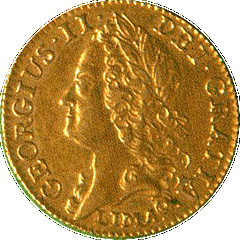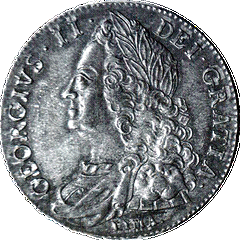THE ENIGMA OF "LIMA"
Jim Duncan
Having dealt with the mystery and perhaps myth of "VIGO"
it seems pertinent to look at the other privy mark of the times - "LIMA".
There are some obvious thoughts that come to mind, and Spanish silver is
the first, from Lima, which lies on the Pacific coast of Peru, 13km inland
from its port, Callao. When I first became aware of 'Lima', back in the
'60s, the story was that Admiral George Anson circumnavigated the world,
and during the course of this voyage he captured a load of Spanish silver.
So this exercise started out with a Google search for Anson. And the
results were very specific. He sailed from England with a squadron of six
ships - Centurion (his flagship), Gloucester, Severn,
Pearl, Wager, the sloop Tryal and two store ships,
Anna and Industry. There were a number of losses along
the way - in fact he ended up with only 335 men out of 961, and just his
flagship Centurion. But there were some rewards. The greatest of
these was the capture of a 'Manilla galleon' - a Spanish ship full of silver
on its way to the Philippines from South America. This was the Nuestra
Señora de Covadonga which was seized off Cape Espiritu Santo. (There
is more than one of these capes in the Pacific, so I can get no closer).
She was carrying 1,313,843 pieces of eight reales, and was taken in June
1743. Wikipedia then says he "took his prize to Macao, sold her cargo
to the Chinese" and sailed for England. First problem. Was it the ship
or the ship AND cargo he sold? If he sold his silver to the Chinese, he
couldn't have brought it back to England. But one has to wonder what he
did bring back - porcelains, silks, spices, gold, what? He certainly had
enough money! (Take care with Wikipedia!)
I referred to some numismatic
books, in the hope of elusive truth. Brooke says "..the treasure
of £500,000 specie brought back by Anson on his return in 1744…".
Craig says "… a windfall, the loot taken in Anson's voyage around
the world…", and, again, as in the Vigo story, Craig uses an odd
date - he says 1748 (the coins are dated 1745 and 1746). I tried the Encyclopaedia
Britannica 2002 ed, where I got "…managed to capture a Spanish
treasure galleon near the Philippines. He sold this prize for £400,000 in
Canton, China, the Centurion being the first British warship to enter Chinese
waters.." This might help identify the particular Cape Espiritu
Santo. But we are no more certain of what happened to the silver. Even Spink
says "…some of the treasure seized by Admiral Anson during his
circumnavigation of the world, 1740-4, and by other privateers…"
Peter Seaby on the other hand, has a different story. He says "In
1745 a great treasure of silver coin had been seized in the North Atlantic
by two British privateers, the Duke and the Prince Frederick, from two French
treasure ships that had come from Peru. This booty was transported in forty-five
wagon loads from the port of Bristol to the mint in London. As the booty
principally consisted of 'piece of eight' bearing the Lima mintmark it was
requested that coins taken from these prizes might bear the name 'Lima'
to celebrate the exploit."
That is twice the idea of "privateers"
has arisen - Seaby and Spink. The Oxford Dictionary defines a "privateer"
as 'an armed ship owned by private individuals, holding a government commission
and authorised for use in war'. So I contacted the Coin Department at the
British Museum where Dr Barrie Cook was kind enough to confirm that Peter
Seaby is right, absolutely, and quotes an article from Seaby's Coin and
Medal Bulletin, March 1970, by Harry Apling, "The Lima Coinage
of George II". He says that Apling sets out to correct the "widespread
but inaccurate" view that the silver was from Anson's voyage, using
contemporary documents in the Gentlemen's Magazine, and internal
Mint documents. He even said that Apling said the mistaken reference first
appeared in a book by Thomas Snelling on English coinage published in 1762!
(View of the Silver Coin & Coinage of England) Anson certainly
did capture treasure, but he apparently spent it in China. Captains Morecock
and Talbot captured the "Lima" treasure, in the Atlantic, not
the Pacific, Ocean.
Dr Cook also commented that there was a medal
struck to commemorate the event, in 1745, and there we have it in Eimer
-
594 Capture of the French Treasure Ships Marquis
d'Antin and Louis Erasmé, 1745.
Obv: Five ships engaged in battle, identified
ND D LE PF MA. Ex. IULI X. MDCCXLV.
Rev: Two infant fames, each
displaying an oval frame with uniformed busts of IAC. TALBOT. and IOHA MORECOCK.
Below a procession of horse-drawn treasure wagons, marked 44 and 45. Ex.
VENIEBUNT LONDO. OCTO.I.ET.II. MDCCLXV. Diameter 38mm, by J Kirk (in silver
and bronze).
James Talbot and John Morecock,
captains of the Prince Frederick and the Duke, captured, in the North Atlantic,
treasure valued at £800,000, which was conveyed to the Tower in forty-five
wagons on 1 and 2 October. The Notre Dame was the only French ship to escape.
This excellent reference seems to confirm that a mistake was made
in 1762 which has been perpetuated ever since! Although there is no mention
of 'Lima'.
I was able to obtain a copy of Mr Aplin's paper, and include
some of it here as confirmation. The two ships (a third ship, the Prince
George, had capsized with heavy loss of life at the beginning of the
voyage) were part of a London-owned group of privateers known as the "Royal
Family", and were cruising the North Atlantic when they discovered
three ships which they approached. A lively set-to ensued in which one French
captain was killed with a pistol shot. This ship surrendered, as, eventually,
did the other, but the third escaped. English marksmanship being what it
was, they had to tow the two French ships back as their masts had been shot
away!
There is even a listing of the booty recovered, and the number
of men killed or wounded.
| The Louis Erasmus carried | ||
| Dollars | 1,277,726 | |
| Pistoles, value in dollars | 221,229 | |
| Gold bars, value in dollars | 30,000 | |
| Wrought plate, value in dollars | 10,000 | |
| ----------- | ||
| 1,538,955 | ||
| The Marquis d'Antin had | ||
| Dollars | 1,387,589 | |
| Doubloons, value in dollars | 79,464 | |
| Gold bars, value in dollars | 2,000 | |
| Wrought plate, value in dollars | 1,000 | |
| ----------- | ||
| 3,009,008 | ||
(Pistoles and Doubloons were, of course, gold coins.) But there was
also 800 tons of cocoa, which in itself must have been worth a good deal.
There were also a number of dignitaries - a marquis of France, a governor
of Peru, and a number of friars.
The Gentlemen's Magazine
reported on Wednesday 16 September, 1745, that 'the proprietors of the two
privateers waited on the King and offered £700,000 - their share of the
prizes - to be immediately employ'd for his majesty's service, which was
accepted and the money is to be repaid by Parliament.'
The silver,
having been transported to The Mint, was subject to an application from
the Bank of England that the word LIMA be placed under the King's head,
and William Chetwynd, the Mint Master, signed a document to this effect
on 11 December, 1745. Howard Linecar rediscovered this document in 1966
in Royal Mint archives. This seems to discount Anson's contribution.
Where had the silver originated? Prisoners brought aboard the Duke
said the ships had come from Callao, Peru.
So what of Anson and his
ship-load? Mr Apling says Anson stayed away from Lima as he did not want
his presence known there, but the ship did go into Paita, 600-odd miles
north of Lima, and plundered it. This was reported by the ship's chaplain.
Apling also reports without explanation that Anson's silver was of Mexican
origin; and he was unable to find reason or evidence why the Bank might
have asked for LIMA on the coins. What did happen to Anson's silver?
The coins which bear the 'LIMA' privy mark are gold 5, 1 and ½ Guinea
pieces; plus silver Crowns of 1746, Half Crowns of 1745, 1746/5 and 1746,
Shillings of 1745, 1746/5 and 1746, and Sixpences of 1745 and 1746. All
from the reign of George II.
 |
 |
We have also discovered the means of apportioning Prize Money (at least
in the time of the Napoleonic wars). Vigo and Lima were both during the
time of the War of the Spanish Succession - a little earlier - but this
may well have applied then too. Two eighths of the prize money went to the
captain - which could set a man up for life! One eighth went to the admiral
who signed the ship's written orders - but if the order came from the Admiralty
this eighth also went to the captain. One eighth was divided among the wardroom
officers (lieutenants, sailing master, surgeon, captain of marines if any).
One eighth was divided among the principal warrant officers, lieutenant
of marines, chaplain and flag secretary if any. One eighth was divided among
the junior warrant and petty officers, their mates, sergeants of marines,
and midshipmen. And the final two eighths were divided among the crew, with
able and specialist seamen receiving larger shares than ordinary seamen,
landsmen and boys. No wonder some senior seafarers were able to do very
well when they came ashore. Some captains even had their own Prize agents
- Admiral Lord Nelson had Alexander Davison to fight ashore on his behalf!
And while this disbursement of money is not directly of numismatic interest,
it does illustrate how the money went around.
Refs:
British Museum, Coins & Medals Dept, Dr
Barrie Cook. (also illustration).
G C Brooke, English Coins, 1966 ed.
Sir John Craig, The Mint, 1953.
Martyn Downer, Nelson's Purse, 2004.
Christopher Eimer, British Commemorative Medals, 1987. (also illustration).
Encyclopaedia Britannica 2002. (under 'Anson').
Seaby's Coin and Medal
Bulletin, March 1970. (copy courtesy John Roberts-Lewis).
Peter Seaby,
The Story of British Coinage, 1990.
Spink, Coins of England and the United
Kingdom, 1999 ed.
Wikipedia. (Anson and Prize Money).